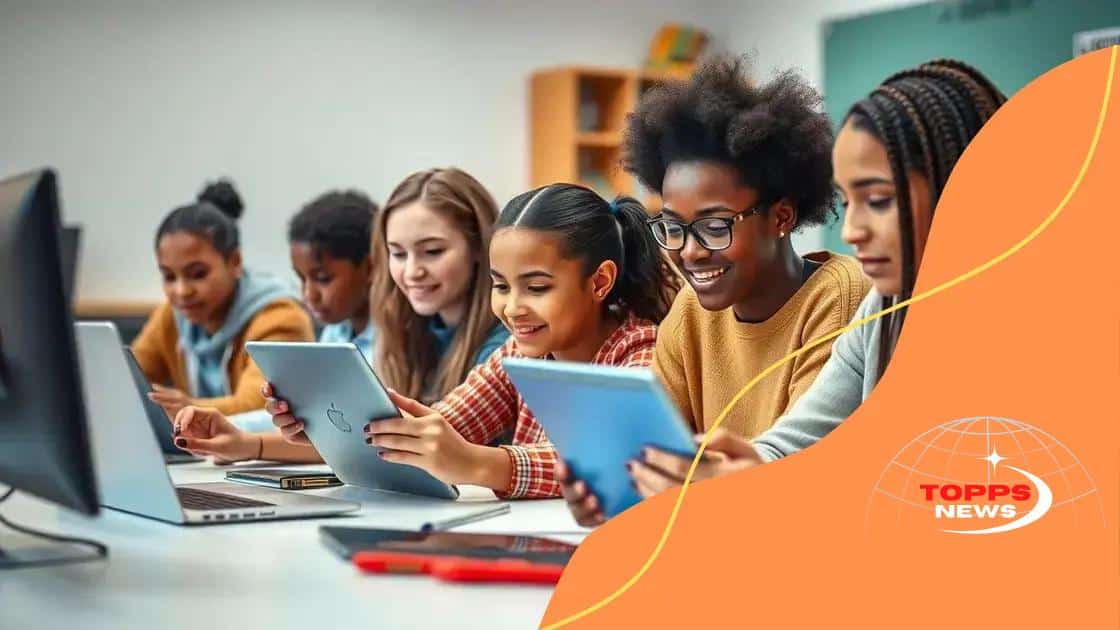Remote learning technology: transforming your education

Remote learning technology enhances education through AI integration, immersive tools, and interactive platforms, providing flexibility, personalized experiences, and improved student engagement while addressing the challenges faced in online learning environments.
Remote learning technology is changing how we think about education. Have you considered how it could enhance your learning experience or that of your children? Let’s explore its impact.
Understanding remote learning technology
Understanding remote learning technology is essential in today’s educational landscape. This technology has transformed how students and educators interact, making learning more accessible and flexible.
What is remote learning technology?
Remote learning technology refers to tools and platforms that facilitate education outside of traditional classrooms. This can include video conferencing software, online learning management systems, and interactive educational apps.
Key components
- Video Conferencing Tools: Applications like Zoom and Microsoft Teams allow real-time interaction.
- Learning Management Systems (LMS): Platforms such as Moodle and Canvas help organize course materials.
- Interactive Learning Apps: Tools like Kahoot and Quizlet encourage engagement through games and quizzes.
When using remote learning technology, students can access lessons anytime, anywhere. This flexibility supports diverse learning styles and paces. For example, some students may prefer to watch lecture videos multiple times to grasp the content better.
Moreover, these technologies often integrate various media formats. This can include videos, podcasts, and interactive exercises that enhance engagement. As a result, learners may find the material more stimulating.
Benefits of remote learning technology
One major benefit is accessibility. Students from different backgrounds can join the same classroom regardless of location. This democratizes education and allows for a more diverse learning environment.
Additionally, remote learning technology often provides personalized learning experiences. Students can work at their own speed, receiving help only when needed. This individualized approach can lead to improved retention and understanding.
In summary, understanding remote learning technology is crucial as it reshapes how we think about education. By embracing these tools, educators can create enriching environments that prioritize student success. As we continue to explore these advancements, it’s clear that the future of education is leaning towards this innovative model.
The benefits for students and educators
Exploring the benefits of remote learning technology is important for both students and educators. This innovative approach to education has transformed how learning takes place, offering various advantages that enhance the educational experience.
Benefits for students
Students enjoy a level of flexibility that traditional classrooms cannot offer. Remote learning technology allows them to attend classes from anywhere, making it easier to balance their studies with other commitments.
- Personalized Learning: Students can learn at their own pace, revisiting materials as needed to fully grasp concepts.
- Access to Resources: With online platforms, students can access a wealth of resources, from videos to interactive exercises.
- Diverse Learning Styles: Remote learning accommodates different preferences, whether visual, auditory, or kinesthetic.
Moreover, engaging with technology prepares students for the future job market. They develop crucial digital skills that are increasingly required in many professions. Virtual interactions also help enhance communication and collaboration among peers.
Benefits for educators
For educators, remote learning technology opens up new avenues for teaching. This includes the ability to reach a broader audience and adapt lessons to fit students’ needs. Educators can leverage different tools to create impactful learning experiences.
- Flexible Teaching Methods: Teachers can incorporate videos, quizzes, and discussion forums into their lessons.
- Enhanced Communication: Online platforms facilitate communication with students, making it easier to provide feedback and support.
- Professional Development: Educators can participate in online training programs to improve their skills.
Additionally, remote teaching encourages educators to be more innovative and responsive to student needs. This adaptability enhances the overall quality of education. The collaboration between educators can lead to sharing best practices and resources, increasing the effectiveness of teaching methods.
In summary, the advantages of remote learning technology for students and educators illustrate its role in enhancing education. By embracing this technology, both groups can benefit from improved experiences and outcomes in the learning process.
Key features of effective remote learning tools

Key features of effective remote learning tools are essential to create a successful online educational experience. These tools enhance engagement and facilitate learning in ways traditional classrooms cannot.
User-Friendly Interface
An effective remote learning tool should be easy to navigate. Students and educators appreciate platforms that are intuitive. A user-friendly interface allows everyone to focus on learning rather than struggling to find resources.
Interactive Elements
Interactive elements, such as quizzes and discussion boards, are crucial. They encourage active participation among students, making lessons more engaging. Furthermore, real-time feedback helps learners understand concepts better.
- Virtual Whiteboards: These allow both teachers and students to collaborate visually during lessons.
- Polls and Surveys: Quick polls can gauge student understanding and gather feedback.
- Gamification: Adding game-like elements can enhance motivation and make learning fun.
Another essential feature is the ability to track progress. Educators need tools that provide analytics on student performance, enabling them to adjust lessons accordingly. This data-driven approach can improve personalized learning.
Accessibility
Accessibility is vital for effective remote learning. Tools should be compatible with various devices and operating systems. This ensures that all students, regardless of their circumstances, can participate in classes.
Moreover, support for different formats is essential. Effective tools accommodate videos, audio, and text-based resources so that every student can engage with the content in a format that suits their learning style.
Strong Communication Features
Lastly, strong communication features are critical in remote learning tools. Options for private messaging, group chats, and video conferences help maintain connections between students and educators.
In summary, focusing on these key features ensures that remote learning tools create an effective and engaging educational environment. Leveraging technology can enhance the learning experience for all involved.
Challenges of remote learning and how to overcome them
Challenges of remote learning can impact both students and educators. Recognizing these difficulties is the first step toward overcoming them and ensuring a successful online educational experience.
Technical Issues
One common challenge is the occurrence of technical issues. Students may face problems such as slow internet connections or device malfunctions. These issues can lead to frustration and disrupt the learning process.
- Solutions: Encouraging students to have backup plans can help. This can include access to alternative devices or locations with better internet connectivity.
- Tech Support: Schools can provide tech support resources to assist students in troubleshooting common problems.
- Regular Checks: Scheduling regular check-ins with students can identify and resolve technical issues early.
Another significant challenge is maintaining student engagement. The lack of a physical classroom environment can make it difficult for students to focus. They may feel isolated or distracted while learning from home.
Overcoming Engagement Issues
To address this, educators can implement interactive activities that encourage participation. Incorporating group projects and discussions can help foster connections among students.
- Incorporating Multimedia: Using videos, games, and simulations can make lessons more interesting.
- Creating a Routine: Establishing a consistent schedule helps students know what to expect each day.
- Feedback and Recognition: Providing regular feedback and recognizing achievements can motivate students to stay engaged.
Moreover, some students may struggle with time management. Without the structure of a physical classroom, they might find it challenging to balance their schoolwork with other responsibilities.
Time Management Strategies
Teaching effective time management skills can be beneficial. Tools such as digital calendars and task lists can keep students organized. Encouraging them to set specific goals can also provide focus.
In addition, it’s essential for parents to be involved. Encouraging a supportive learning environment at home can help students stay on track. Regular communication between educators and parents can ensure that everyone is aware of student progress.
By recognizing these challenges and implementing strategies to overcome them, both educators and students can adapt to the remote learning environment. Being proactive can lead to a more effective and enjoyable educational experience.
Future trends in remote learning technology
Future trends in remote learning technology show great promise for enhancing education. As technology evolves, so do the methods we use to teach and learn. Understanding these trends helps students and educators prepare for the future of education.
Artificial Intelligence Integration
One of the most significant trends is the integration of artificial intelligence (AI) in learning platforms. AI can analyze student performance and suggest personalized learning paths. This customization allows students to learn at their own pace, adapting to their individual needs.
- Adaptive Learning Systems: These systems can change content difficulty based on student performance.
- Intelligent Tutoring Systems: AI can provide real-time feedback and assistance, acting as a virtual tutor.
- Data Analytics: Educators can access insights about class performance to improve teaching strategies.
Another emerging trend is the rise of immersive technologies like virtual reality (VR) and augmented reality (AR). These tools create engaging learning experiences that can transport students to different environments or simulate real-life scenarios. For example, history lessons can come alive through virtual field trips.
Collaboration and Social Learning
Collaboration tools are also evolving. Platforms that promote social learning can enhance interaction among students. These tools allow learners to work together on projects, even if they are miles apart. Video conferencing, shared documents, and discussion forums foster teamwork.
Learning through collaboration helps students develop crucial communication skills, preparing them for future workplaces. Group projects using online platforms can mirror real-world scenarios, making education more relevant.
Focus on Mental Well-Being
As remote learning becomes more common, there is a growing emphasis on mental well-being. Educators are recognizing the importance of emotional support in the learning process. Tools that provide guidance on stress management and mental health resources are increasingly vital.
Additionally, training programs for teachers focusing on emotional and psychological support are becoming more common. This approach helps create a more supportive learning environment, benefiting student performance.
In summary, the future of remote learning technology holds exciting possibilities that can transform education. With advancements in AI, immersive technologies, collaboration tools, and a focus on mental health, we can expect a more engaging and supportive learning experience for all.
FAQ – Frequently Asked Questions about Remote Learning Technology
What are the main benefits of remote learning technology for students?
Remote learning technology provides flexibility, personalized learning experiences, and access to a wealth of digital resources, enhancing engagement.
How can educators enhance student engagement in remote learning?
Educators can enhance engagement by using interactive activities, incorporating multimedia tools, and fostering collaboration among students.
What role does AI play in remote learning platforms?
AI helps personalize learning by analyzing student performance, suggesting tailored learning paths, and providing real-time feedback.
How can schools support students’ mental well-being during remote learning?
Schools can provide resources, training for teachers, and encourage open communication about emotional support to help students cope.





